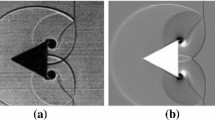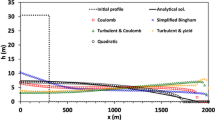Abstract
Predicting the motion of driftwood around hydraulic structures such as bridge piers and spur dikes is important. We propose a numerical model for simulating driftwood motion that is based on coupling an Eulerian-type three-dimensional flow model and a Lagrangian-type two-dimensional driftwood model. Laboratory tests were carried out on the driftwood motion in a curved channel and around obstacles to obtain reference data. The computational results showed that three-dimensional flow features considerably affect the motion of driftwood in a curved channel. We defined the driftwood Richardson number (DRI) to classify the three-dimensional behavior of driftwood around obstacles. The experimental results showed that an increasing DRI indicates more three-dimensional behavior by driftwood and a decreased capture ratio by obstacles. We also developed a two-way model in which the drag force from driftwood on the flow is modeled to simulate the backwater elevation and the flow deceleration behind the stacked driftwood. The computational results showed that the two-way model could reproduce the increase of water level and the decrease of velocity at the upstream region of the obstacles. However, such effects caused by the driftwood jamming were underestimated if the jamming happened in a three-dimensional manner.




















Similar content being viewed by others
References
Davidson SL, MacKenzie LG, Eaton BC (2016) Large wood transport and jam formation in a series of flume experiments. Water Resour Res 51:10065–10077
Gotoh H, Okayasu A, Watanabe Y (2013) Computational wave dynamics, vol 87. Advanced series on ocean engineering. World Scientific, Singapore
Hatta N, Akahori R, Shimizu Y (2012) Experimental study and numerical analysis on field on meandering channel and movement of woody debris. J Appl Mech JSCE 15:415–422
Kang T, Kimura I (2018) Computational modeling for large wood dynamics with root wad and anisotropic bed friction in shallow flows. Adv Water Resour 121:419–431
Kimura I, Hosoda T (2003) A non-linear k–ε model with realizability for prediction of flows around bluff bodies. Int J Numer Meth Fluids 42(8):813–837
Kimura I, Uijttewaal WSJ, Hosoda T, Ali MS (2009) URANS computations of shallow grid turbulence. J Hydraul Eng, ASCE 135(2):118–131
Kitazono, K, Kimura, I, Shimizu, Y, Kyuka, T (2016) Computation on driftwood motions around obstacles coupling with a three-dimensional flow model. In: Proceedings of 19th congress of the Asia Pacific Division of the International Association for Hydro Environment Engineering & Research, Colombo, Sri lanka, pp 1–8
Koshizuka S (1997) Computational fluid dynamics. Baifukan Co. Ltd, Tokyo (in Japanese)
Nelson JM, Shimizu Y, Abe T, Asahi K, Gamou M, Inoue T, Iwasaki T, Kakinuma T, Kawamura S, Kimura I, Kyuka T, McDonald RR, Nabi M, Nakatsugawa M, Simões FR, Takebayashi H, Watanabe Y (2016) The international river interface cooperative: public domain flow and morphodynamics software for education and applications. Adv Water Resour 93:62–74
Persi E, Petaccia G, Fenocchi A, Manenti S, Ghilardi P, Sibilla S (2019) Hydrodynamic coefficients of yawed cylinders in open-channel flow. Flow Meas Instrum 65:288–296
Prandtl L (1942) Führer durch die Strömungslehre. Vieweg, Braunschweig, pp 130–134
Ruiz-Villanueva V, Bladé E, Sánchez-Juny M, Marti-Cardona B, Díez-Herrero A, Bodoque JM (2014) Two-dimensional numerical modeling of wood transport. J Hydroinformatics 16(5):1077–1096
Schmocker L, Weitbrecht V (2013) Driftwood: risk analysis and engineering measures. J Hydraul Eng, ASCE 139(7):683–695
Shrestha, BB (2009) Study on mitigation measures against debris flow disasters with driftwood, Thesis or Dissertation, Kyoto University, pp 1–179
Shrestha BB, Nakagawa H, Kawaike K, Baba Y, Zhang H (2009) Numerical simulation on debris-flow with driftwood and its capturing due to jamming of driftwood on a grid dam. Ann J Hydraul Eng, JSCE 53:169–174
Shrestha BB, Nakagawa H, Kawaike K, Baba Y, Zhang H (2012) Driftwood deposition from debris flows at slit-check dams and fans. Nat Hazards 61:577–602
Ushijima S, Makino O, Yoshikawa N (2009) 3D numerical prediction for transportation and entrapment of driftwood with T-type solid model. J Hydrosci Hydraul Eng, JSCE 27(1):11–21
Author information
Authors and Affiliations
Corresponding author
Additional information
Publisher's Note
Springer Nature remains neutral with regard to jurisdictional claims in published maps and institutional affiliations.
Appendix: DEM formula on a generalized curvilinear coordinate
Appendix: DEM formula on a generalized curvilinear coordinate
The discrete element method (DEM) approach was used to evaluate the collision effects of driftwood pieces in this study. This process is done on a generalized curvilinear coordinate. The DEM equations on a generalized curvilinear coordinate system are not commonly employed; therefore, we describe them here.
Figure 21 shows a collision of two spheres (sphere i and sphere j) on a 2D generalized curvilinear coordinate system (ξ-η coordinate). The location vectors at the centers of spheres i and j are defined as ri and rj, respectively, as follows.
where \({\mathbf{e}}_{\xi} , {\mathbf{e}}_{\eta }\) are covariant base vectors. The relative location vector from the center of sphere i to the center of the sphere j, \({\mathbf{L}}_{ij}\) and its norm |Lij| (= the distance of the centers of two spheres) are defined as
where \(g_{\xi \xi }\), \(g_{\xi \eta }\) and \(g_{\eta \eta }\) are coefficients of connections (see Eq. (6)). We consider the relative location vector varies during a time step \(\Delta t\) as follows
where
The components of the relative velocity vector between the two spheres is expressed as:
The displacements in the normal and tangential directions (ΔNi j and ΔTi j) are defined as
where
The relative velocity between two spheres in the normal direction (= vij,n) and the tangential direction (= vij,t) are
Using these relations, the forces in the normal and tangential directions are evaluated with spring and dashpot models as in the original DEM approach [2] as follows:
Repulsion force in the normal direction, Fn:
Shear force in the tangential direction, Ft:
where kn and cn are the spring and dashpot coefficients in the normal direction, respectively, and kt and ct are the spring and dashpot coefficients in the tangential direction, respectively.
The tension force between two spheres is neglected; thus, the following relation is used:
If the shear force exceeds the maximum static friction force, the slider is activated, and the shear force is thus recalculated as
These normal and tangential forces are calculated in all colliding spheres, and thus they are transformed into the values in a generalized curvilinear coordinate. Taking the summation of all forces of hitting spheres, we can evaluate the colliding forces in the ξ and η directions in each sphere as
Rights and permissions
About this article
Cite this article
Kimura, I., Kitazono, K. Effects of the driftwood Richardson number and applicability of a 3D–2D model to heavy wood jamming around obstacles. Environ Fluid Mech 20, 503–525 (2020). https://doi.org/10.1007/s10652-019-09709-6
Received:
Accepted:
Published:
Issue Date:
DOI: https://doi.org/10.1007/s10652-019-09709-6





